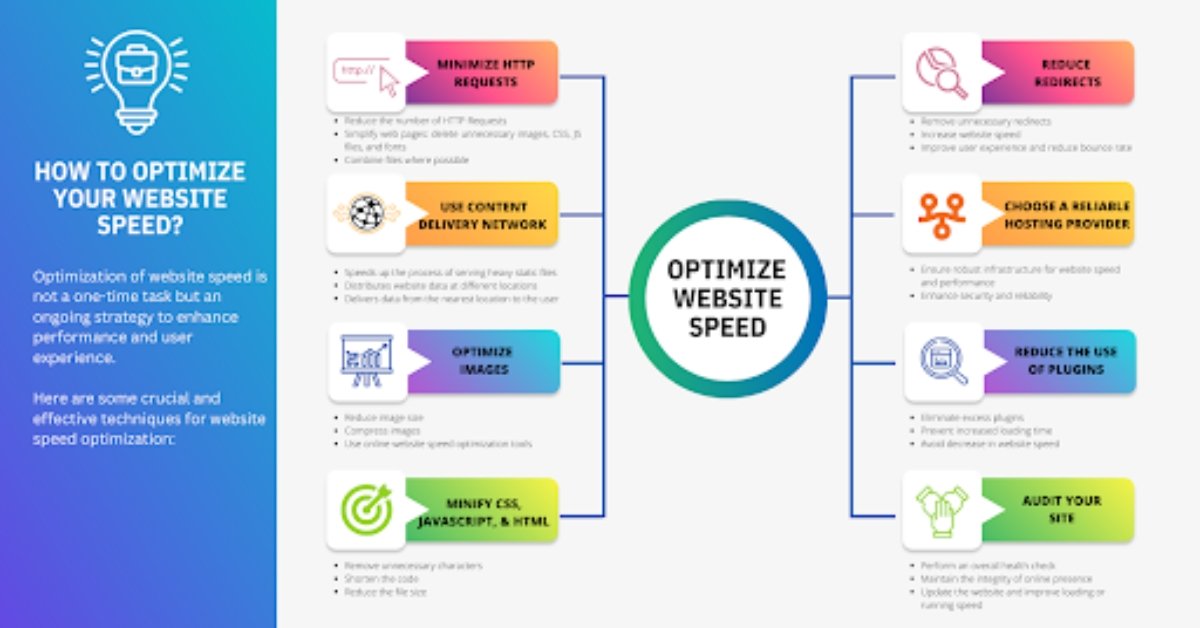Website speed optimization can be considered an injection that “speeds up” your site to load and run faster. Higher website speed will help boost the performance as well as retain your users better.
Speed is critical if you’re running any kind of blog, e-commerce site, or any other type of business website! Not only does a slow-moving site have the chance to rank lower in Google searches, but it can also impact Google page loading speed. But the faster your website is, the more chances there will be for surfing, exploring, and ranking.
So, we have brought this informative guide to assist you with optimizing website speed. So keep reading and get some of the best new website speed optimization techniques.
What is Website Speed Optimization?
Website speed optimization is around to make your webpage quicker for users. It’s about altering your site so that it takes less time to load up the content. One can do that using different website speed optimization techniques to quicken up the site.
The optimization of website speed is critical to improving functionality and user retention. It not only enhances UX but is a ranking factor for search engines, too. If you have a fast website speed, then your website can be ranked at the top of the Google search results.
Additionally, a quick site can lead to a lower bounce rate. For example, if your website is having trouble loading and taking longer to open, people may leave it. Therefore, website speed optimization is necessary to decrease the bounce rate and increase ranking.
How To Optimize Your Website Speed?
Website speed optimization is most important for boosting performance and improving user experience. It is just like making some tweaks and changes to the website to make it run faster. Here are some website speed optimization techniques to improve the speed of your website:
1. Minimize HTTP Requests
The first website optimization technique is to reduce the number of HTTP requests. When web browsers are loading your page, they’ll send out various HTTP requests asking for bits of your page, such as Images and Text. If your web page receives many such requests, they slow down your page speed. Therefore, a critical aspect of website speed optimization is reducing the number of HTTP requests.
To minimize unnecessary HTTP requests, make your web pages as simple as possible. To do that, just delete unnecessary images, CSS, JS files, and fonts. In addition, you can mix several of these things. For example, you may take a single file as your stylesheet or use CSS instead of images.
2. Use a Content Delivery Network (CDN)
Optimizing website speed through the use of a Content Delivery Network (CDN) is crucial for enhancing user experience. By distributing heavy static files across various locations, a CDN accelerates data delivery, ensuring quick access for users. However, maintaining website performance involves more than just CDN implementation. It requires consistent testing and monitoring. In regions like China, this maintenance presents unique challenges. VPN connections, which are widely used for secure site maintenance globally, offer a solution to these challenges. Despite China’s stringent internet regulations, including the Great Firewall, VPN services in China can help businesses navigate these restrictions and ensure timely access to their websites for Chinese users. By selecting reliable VPN providers, businesses can overcome connectivity issues and maintain optimal website performance.
3. Minify CSS, JavaScript, and HTML
Another website optimization technique is to minify CSS, JavaScript, and HTML. Manifestation is actually removing unnecessary characters like spaces and line breaks to shorten the code. This will also reduce the file size. It helps your website load and run faster. You can do this manually or using any online website speed optimization tools.
4. Reduce Redirects
Redirect happens when a user visits your website and tries to open something but gets sent to another page. This reduces user experience and increases bounce rate, which is definitely not suitable for your website. So, for website speed optimization, it is essential to reduce redirects. By removing unnecessary redirects, you can increase your website speed. Although redirects are essential initially, it is better to remove them as soon as possible.
5. Choose a Reliable Hosting Provider
Choosing a reliable hosting provider is an essential website optimization technique. Website hosting is like your website home, where your data is stored. If the hosting is not reliable and secure, your website may run slower. Good hosting has a robust infrastructure that ensures your website’s speed and performance. If you need a reliable hosting provider, explore these best web hosting services to enhance your site’s performance and user retention.
6. Reduce the Use of Plugins
The reduction of plugins is one way of optimizing your website speed. Plugins are like an extension to your site; they help your site perform better. But at the same time, installing too many plugins may harm your website speed. Every plugin adds lines of codes, which increase the loading time and ultimately decrease the speed of the website. Then, when you optimize the website’s speed, be sure you get rid of excess stuff with plugins, too.
7. Audit Your Site
Auditing your site is just like the overall health check for your website. You can optimize the speed of your website, which assists in better performance. An audit can be a perfect way to maintain the integrity of your online presence, make you update your website, and improve how fast your website loads or runs, as this can save you from problems.
Conclusion
So the result is that your site must be optimized in order to function well as well as retain the users. A site loading at sluggish speed can dishearten the user, who may not revisit it again! In contrast, a quick, effective website keeps consumers hooked, enhances their total experience, and motivates them to remain longer. Invest in website speed optimization to improve website performance, rank higher on search engines, and grow visitor return rate. In the digital world where time is of the essence, ensure that your website loads swiftly and seamlessly on all user devices.









